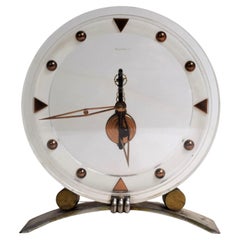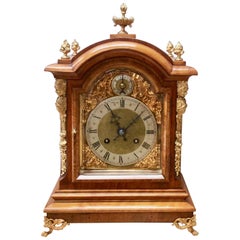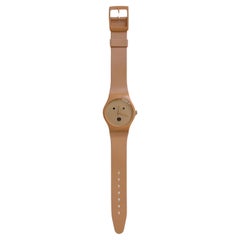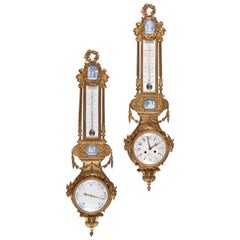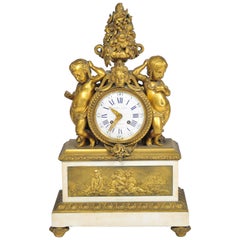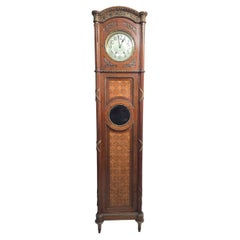Europe - Clocks
to
275
2,990
236
7
250
1,623
1,117
243
325
456
274
71
48
70
61
22
69
127
142
71
27
251
240
211
207
197
140
137
100
87
84
74
37
33
24
18
17
15
9
2,350
845
815
657
587
3,233
2,042
2,953
1,384
473
362
239
Height
to
Width
to
3,233
3,048
3,162
74
36
35
35
26
Item Ships From: Europe
Vintage Art Deco Baguette Mod. 234 Clock from Jaeger-LeCoultre
By Jaeger-LeCoultre
Located in Purkersdorf, AT
A very early avant-garde baguette watch by Jaeger-le-Coultre.
Signed.
This model (No. 234) was the first to use acrylic glass.
The watch is working.
Category
1930s Swiss Art Deco Vintage Europe - Clocks
Materials
Brass
Victorian Walnut Cased Striking Mantel Clock
Located in Norwich, GB
Late Victorian walnut break arch mantel clock standing on a raised plinth and resting on four outswept gilded paw feet and surmounted by four flame finials and a central finial.
H...
Category
19th Century German Victorian Antique Europe - Clocks
Materials
Walnut
'90s Wristwatch "Ollo" by Museo Alchimia Alessandro Mendini, Italy
By Alessandro Mendini, Studio Alchimia
Located in Milano, IT
Alessandro Mendini's wristwatch, crafted during the 1990s for the Museo Alchimia, served as a pioneering prototype for Swatch, a renowned company for wh...
Category
1990s Italian Post-Modern Europe - Clocks
Materials
Stainless Steel
French Gilt Bronze and Blue and White Jasperware Clock and Barometer Set
By Carcany & Robin
Located in London, GB
A fine quality clock and barometer set by Carcany and Robin, after models on exhibition in the Louvre Museum, Paris.
In the Louis XVI manner, of banjo form, the cases being in cr...
Category
19th Century French Louis XVI Antique Europe - Clocks
Materials
Bronze
19th Century French Mantel Clock, by 'Monbro Aine, Paris'
By Monbro Ainé 1
Located in Brighton, Sussex
A very good quality, large French 19th century gilded ormolu and white marble mantel clock, signed; 'Monbro Aine, Paris'. Having an urn of grapes with semi...
Category
1860s French Napoleon III Antique Europe - Clocks
Materials
Marble, Ormolu
Exotic Wood and Mother-of-Pearl Inlay Longcase Clock – 20th Century
Located in Madrid, ES
Superb tall longcase clock, crafted from finely crafted exotic woods and decorated with mother-of-pearl inlays forming an elegant geometric pattern. The brass details and marquetry h...
Category
Mid-20th Century European Other Europe - Clocks
Materials
Mother-of-Pearl, Wood
Early 19th Century French Empire Pendule Portefaix circa 1810 Paris
Located in Münster, DE
Paris, Empire, c. 1810, bronze body, fire-gilt and patinated, designed by Jean-André Reiche in 1808, 8-day movement, enamel dial with Roman numerals, figure of the wearer on an oval ...
Category
Early 19th Century Antique Europe - Clocks
Materials
Bronze, Enamel
Jaeger LeCoultre Mid-Century Marina Mantel Clock with Oriental Theme No. 349
By Jaeger-LeCoultre
Located in London, GB
Stunning Jaeger LeCoultre mid-century marina desk clock with an Oriental theme, number 349. The clock has a polished gilt brass and lucite case. It is beautifully decorated with an O...
Category
1960s Swiss Mid-Century Modern Vintage Europe - Clocks
Materials
Brass
Antique Mora Clock Swedish 1800s Antique Tall J. Svensson Svenstad A
Located in Lewes, England
Shipping special update - We have negotiated a special flat rate shipping cost to the USA with our main US shipping partner for our 1st dibs clients of only £995 export crated by ai...
Category
Mid-19th Century Swedish Gustavian Antique Europe - Clocks
Materials
Wood
$2,803 Sale Price
54% Off
Louis XVI Style Mahogany Cartel Clock and Barometer, After Carlin, circa 1870
By Martin Carlin
Located in Brighton, West Sussex
A fine Louis XVI style gilt-bronze mounted mahogany cartel clock and barometer, after the model by Martin Carlin.
French, circa 1870.
The dial sig...
Category
Late 19th Century French Louis XVI Antique Europe - Clocks
Materials
Bronze
19th Century French Enamel Clock Set
Located in Brighton, Sussex
A wonderful quality late 19th century French Louis XVI style gilded ormolu and Champlevé enamel clock garniture, the clock having a two handled turquoise enamel urn with swags above ...
Category
Late 19th Century French Louis XVI Antique Europe - Clocks
Materials
Enamel, Ormolu
$12,217 / set
Early 19th Century Marble Clock Cupid Reading by Ledure and Hémon
By Pierre-Victor Ledure
Located in Paris, FR
Early 19th century Restauration-period green vert-de-mer marble clock with gilt bronze decoration. The clock is topped by a Cupid reading in patinated bronze. The ormolu face marks t...
Category
Early 19th Century French Restauration Antique Europe - Clocks
Materials
Marble, Bronze
Large Louis XVI-style pendulum clock Paris, late 19th century
Located in Berlin, DE
Large Louis XVI-style pendulum clock
France, late 19th century
Bronze, gilt. On gyratory feet, a tapered, partially latticed case with lion masks, drapery, and scale decoration on th...
Category
1860s French Antique Europe - Clocks
Materials
Bronze
$4,696 Sale Price
20% Off
1970s Mirrored Crystal Cut Glass Clock by Junghans & Joska, Germany
By Junghans Uhren GmbH, Palwa
Located in Andernach, DE
Unusual large wall clock by famous German clock makers Junghans.
Here in collaboration with ''Joska Glass'' makers with cut glass roses in a typical mid-ce...
Category
Mid-20th Century German Hollywood Regency Europe - Clocks
Materials
Crystal
Vintage Modernist Metal Brass Table Clock by Diehl Dilectron, Germany 1960s
Located in Kirchlengern, DE
Article:
Table Clock
Origin:
Germany
Producer:
DIEHL, Germany
Age:
1960s
This original wooden table clock wa...
Category
Late 20th Century German Mid-Century Modern Europe - Clocks
Materials
Metal
Desk clock Goddess Fortuna "medicine" with miniature doctor's tools
By Creazioni Sacchetti
Located in VALENZA, IT
Miniature and Sterling Silver Desk Clock and wood.
The base is made of wood. Above it, the following 925 silver parts were made and placed:
Goddess of Fortune holding a scroll engr...
Category
Late 20th Century Italian Other Europe - Clocks
Materials
Sterling Silver
$1,407 Sale Price
20% Off
Orologio da tavolino vintage in bronzo 2000
By Mice di rugiano domenico e c. s.n.c.
Located in Cantù, IT
Orologio da tavolino vintage in bronzo (batteria) - Private Collection Domenico Rugiano
Category
Early 2000s Italian Other Europe - Clocks
Materials
Brass
$1,417 / item
French 19th Century Bronze with Marble Base Mantel Clock, Pendule
Located in Delft, NL
French 19th century Bronze with marble base mantel clock, pendule
A 19th century French mantel clock with bronze putti on a brown, red, whi...
Category
19th Century French Antique Europe - Clocks
Materials
Marble, Bronze
Daum France, Anemone Table Clock, France 1970s
By Daum
Located in PARIS, FR
Superb Anemone clock in Daum crystal from the 1970s. Signed Daum France.
Very good condition. Clock system is original and needs to be replaced by a modern system to function.
Dimen...
Category
1970s French Mid-Century Modern Vintage Europe - Clocks
Materials
Crystal
Art Deco Clock Set ~ Elephants
Located in Belper, Derbyshire
A beautiful and high quality Art Deco clock set featuring two elephants standing beside the clock. The case is formed of stunning specimen marbles i...
Category
Early 20th Century French Art Deco Europe - Clocks
Materials
Marble, Metal
$4,004 / set
EARLY 19th CENTURY FRENCH PORCELAIN CLOCK
Located in Firenze, FI
Elegant biscuit watch with an allegory of pure love. The spring-loaded watch features an enamelled dial with double Arabic and Roman numerals, and a crown set with zircons cut like d...
Category
Early 19th Century French Empire Antique Europe - Clocks
Materials
Porcelain
Impressive Quarter Chiming Tubular Gong Longcase Clock
By Maple & Co.
Located in Amersham, GB
A very impressive quarter chiming tubular gong clock with a very high quality three train movement. The movement is of 8 day duration and strikes the quarter hours on eight chrome plated tubular gongs hanging from the rear of the case and the main hour on a coiled gong. Also featuring Westminster and Whittington chime...
Category
1890s English Edwardian Antique Europe - Clocks
Materials
Brass, Steel, Chrome
Wonderful Antique Victorian quality eight day movement marble clock set
Located in Ipswich, GB
Wonderful Antique Victorian quality eight day movement marble clock set, having a black marble case with four reeded columns, a dome top, round enamel brass dial with original hands ...
Category
Early 19th Century Victorian Antique Europe - Clocks
Materials
Marble
German Ceramic Wall Clock by Garant
Located in Vienna, AT
Ceramic clock with a mechanic movement with floating anchor made my Garant (later Hugo Hättich) in Germany in the early 1950s.
Delivery time about 2-3 weeks.
The movement will be...
Category
1950s German Mid-Century Modern Vintage Europe - Clocks
Materials
Ceramic, Glass
NSNG One More Time Clock Patinated Brass
By Joost van Bleiswijk, Kiki & Joost
Located in Eindhoven, NL
No Screw No Glue is an iconic range of furniture and objects designed by Joost Van Bleiswijk in which the components are laser cut and assembled by slotting the pieces together. As t...
Category
21st Century and Contemporary Dutch Modern Europe - Clocks
Materials
Brass
$2,934 / item
Orologio in bronzo raffigurante moschettiere con cavallo e cane
By Mice di rugiano domenico e c. s.n.c.
Located in Cantù, IT
Orologio in bronzo raffigurante moschettiere con cavallo e cane
Category
20th Century Italian Other Europe - Clocks
Materials
Bronze
20th Century Gilt Bronze and Antimony French Table Clock, 1930
Located in Vicoforte, Piedmont
French clock from the first half of the 20th century. Gilt bronze and antimony object, patinated and chiseled adorned with sculptures, mahogany-colored lacquered wooden base. Clock s...
Category
Mid-20th Century French Europe - Clocks
Materials
Bronze
Wall Clock Eos & Diana By Gerhard Malmberg For Mjolby Intarsia
By Mjölby Intarsia
Located in Vienna, AT
An original handcrafted inlaid wall clock "Eos & Diana" with different kind of wood designed by Gerhard Malmberg in the 1930 and manufactured by Mjolby Intarsia in Sweden. New batter...
Category
1930s Swedish Art Deco Vintage Europe - Clocks
Materials
Softwood
Clock Set in Marble and Bronze by F.Gervais
By Ferdinand Gervais
Located in Los Angeles, CA
Truly unique clock set in pink marble and bronze decorative piece of art
the clock is modelled in the image of an 18 century sedan chair that is covered ...
Category
1870s French Louis XVI Antique Europe - Clocks
Materials
Marble, Bronze
Fancy Antique Wall Clock, circa 1850
Located in Berlin, DE
Fancy antique wall clock, circa 1850.
Octagonal-shaped and black-framed body with glazed door. White dial. Hand-inserted inlaid brass elements in Boulle technique. Movement must be ...
Category
Mid-19th Century Antique Europe - Clocks
Materials
Wood
Empire Clock in the Form of a Classical Urn, by Maison Lepautre, circa 1825
By Pierre-Basile Lepaute
Located in Brighton, West Sussex
A gilt bronze Empire clock in the form of a classical urn, by Maison Lepautre.
French, circa 1825.
The dial signed 'Lepaute a Paris'.
The clock has an ornate cast bezel with a 3-inch porcelain dial with Roman numerals and Breguet style hands. The twin train eight-day movement with outside count wheel striking on a bell and silk thread suspension.
This elegant Empire style clock has a gilt bronze case in the form of a classical urn with swan neck handles and a winged cherub to the neck. The circular pedestal base is raised on a footed stepped square plinth.
The Lepaute family were the premier French clockmakers of their day. Their significance lies in their contribution to the clock making industry which had hitherto come under the trade of locksmiths. The family held the brevet Horlogers du Roi.
Jean-André Lepaute (1720–1789) arrived in Paris at an early age and in 1740 founded the family business. A skilled artist and mechanic, he quickly gained an excellent reputation. He was received as maître by the clockmakers guild in 1759, was granted royal lodgings from the king in The Luxembourg Palace, and was entrusted with the construction of the majority of the great public clocks of Paris. He executed, amongst others, those in The Luxembourg Palace, the Jardin des Plantes, the Château de Bellevue and the Château des Ternes. His clock at Paris’s École Militaire still works today. Three editions of his Traité d’Horlogerie were published in Paris in 1755, 1760 and 1767. A small volume, Description de Plusieurs Ouvrages d’Horlogerie appeared in 1764. Jean-André’s wife, Nicole-Reine Etable de la Brière (1723-1788), was a highly esteemed mathematician and astronomer. Her passion for science lent itself to Lepaute’s work and she played an active role in the scientific and mathematical aspects of the clock making.
Jean-André’s younger brother Jean-Baptiste Lepaute (1727-1802) joined him in Paris in 1747 and immediately started working for the family business. He was received as maître in 1776 and was known for the clocks he constructed for the Paris Hôtel de Ville (1780), destroyed in a fire of 1871, and for the Hôtel des Invalides (1784). Jean-Baptiste took over the workshop when Jean-André retired in 1775.
After Jean-Baptiste’s death in 1802, the firm was taken over by his nephew Pierre-Basil Lepaute (1750-1843) where he was duly joined by his own nephew Jean-Joseph (1768-1846) and son Pierre-Michel (1785-1849). By 1816, Pierre-Michel Lepaute was in charge of the business. His masterpieces include the astronomical clock in Paris’s Bureau...
Category
Early 19th Century French Empire Antique Europe - Clocks
Materials
Bronze
Clock Set in Bronze Three Pieces
Located in Los Angeles, CA
Clock set three pieces louis XV style in bronze ,quality and detail are very finely executed
Dimensions of the candelabras
H: 11 inch W: 6.5
Clock dimension are in description.
Category
1890s French Louis XV Antique Europe - Clocks
Materials
Bronze
vintage mid century europa elomatic WALL CLOCK black metal brass 1960s
Located in Mannheim, DE
1960s mid century wall clock manufactured by Europa Elomatic. Works with battery works (battery is not included). Made of matte black metal and brass.
Dimensions: Diameter 12 1/2" (...
Category
1960s German Mid-Century Modern Vintage Europe - Clocks
Materials
Metal
Wonderful Baroque style brass clock to stand on
By Mice di rugiano domenico e c. s.n.c.
Located in Cantù, IT
Wonderful Baroque style brass clock to stand on
Category
19th Century Italian Other Antique Europe - Clocks
Materials
Brass
Nomon Barcelona Premium Wall Clock By Andres Martinez
By ANDRÉS MARTÍNEZ
Located in Brooklyn, NY
Renovation of one of the most representative models of nomon, the iconic Barcelona clock. Incorporating a more glamorous style in the design.
It stands out for the brass finish in its fiberglass double...
Category
21st Century and Contemporary Spanish Modern Europe - Clocks
Materials
Fiberglass, Walnut
Marble Mantel Clock with Matching Vases, circa 1830
Located in Greding, DE
A refined neoclassical garniture set comprising a marble mantel clock and two matching vases (20 x 13 x 13 cm). The clock features a vase-shaped body crafted in white marble with dar...
Category
1830s European Biedermeier Antique Europe - Clocks
Materials
Marble
Art Deco Chrome Mantel Clock by Davall, England
Located in Norwich, GB
Art Deco chrome mantel clock standing bon double stepped pad feet in a square case with bevelled glass.
Black velvet dial mask, silvered chapter ring with Arabic numerals and or...
Category
1920s English Art Deco Vintage Europe - Clocks
Materials
Chrome
Napoleon III Clock Garniture Designed by Sévin, Cast by Barbedienne
By Louis-Constant Sevin, F. Barbedienne Foundry
Located in Brighton, West Sussex
A fine Napoleon III gilt-bronze and porcelain mounted clock garniture, designed by Louis-Constant Sévin, cast by Ferdinand Barbedienne, The Movement by Japy Frères.
Frédéric Japy ...
Category
19th Century French Napoleon III Antique Europe - Clocks
Materials
Ormolu
Floating Frames Mantel Clock Brass and Sandblasted
By Kiki van Eijk, Kiki & Joost
Located in Eindhoven, NL
Kiki van Eijk designed floating frames as a collection of handmade objects in anodized aluminum wire. Each piece is meticulously handmade in her workshop; no two items are alike.
...
Category
21st Century and Contemporary Dutch Modern Europe - Clocks
Materials
Brass
$2,002 / item
19th Century French Pink Porcelain Clock by Japy Fréres in the Louis XVI Manner
By Japy Frères
Located in London, GB
A table clock in the Louis XVI Manner
By Japy Frères
The finely chased ormolu case is dressed with pink 'Sèvres' style hand decorated polychrome panels to the face and sides, dep...
Category
19th Century French Louis XVI Antique Europe - Clocks
Materials
Ormolu, Bronze
Vintage 1960s Modernist Wooden Teak Brass Table Clock by Dugena, Germany
Located in Kirchlengern, DE
Article:
Table clock
Origin:
Germany
Producer:
Dugena, Germany
Age:
1960s
This original wooden table clock was produced in the 1960s by the pr...
Category
Late 20th Century German Mid-Century Modern Europe - Clocks
Materials
Metal
Large Grey Industrial Factory Wall Clock from Pragotron, 1960s
By Pragotron
Located in Kojetice, CZ
Pragotron wall clock made in former Czechoslovakia during the 1960s. It features a grey metal body, a metal dial and a clear glass cover. The piece has been converted into a battery-...
Category
Mid-20th Century Czech Industrial Europe - Clocks
Materials
Iron
An Arts and Crafts hand formed copper and turquoise blue enamel wall clock
Located in London, GB
An Arts and Crafts hand-formed copper and turquoise blue enamel wall clock that is designed to hang on the angle. Finely detailed sunrise amongst trees in the centre.
Category
Early 1900s English Arts and Crafts Antique Europe - Clocks
Materials
Copper
Square Atlanta Electric Table Clock, by Kienzle Germany 1960s
By Kienzle Clocks
Located in Den Haag, NL
German desk clock from the 1960s Atlanta electric It is made of White colored Brass base , in the shape of a cube with hands and hour markers, also made of brass. It has a back that...
Category
1960s German Space Age Vintage Europe - Clocks
Materials
Metal
Louis XV Style Bronze Figural Clock Garniture by Maison Baguès French circa 1870
By Maison Baguès
Located in Brighton, West Sussex
A fine Louis XV style gilt and Patinated bronze figural clock garniture by Maison Baguès.
This rare example of a clock garniture by Maison Baguès has a twin train eight-day movement striking on a bell.
The garniture consists of a clock and a pair of candelabra en suite.
The clock has a Rococo cast case surmounted by a patinated bronze putto playing a lyre, above a circular white enamel dial with Roman numerals, Arabic seconds and pierced hands. The dial inscribed 'Eug Bagues, Paris'. The case terminates in four scrolling legs put down on an acanthus cast plinth base.
The candelabra en suite have gilt bronze pierced acanthus cast bases supporting patinated bronze putti each holding aloft three scrolling acanthus arms terminating in circular and foliate cast drip trays and nozzles.
Maison Baguès
The Baguès Company, located at 31, rue des Francs-Bourgeois, was founded in 1840 by Mr. Noel Baguès who started his business to cast liturgical bronzes.
By 1880 the company had expanded into the production of bronze light fixtures in response to the development of electrical lighting. Carried on by Noël’s son Eugène and grandsons Victor and Robert, Maison Baguès continued to progress, adding intricately detailed iron lighting collections in the 1920s as well as stair banisters...
Category
Mid-19th Century French Louis XV Antique Europe - Clocks
Materials
Bronze
Antico orologio oro argento
By Mice di rugiano domenico e c. s.n.c.
Located in Cantù, IT
Antico orologio oro argento Antico orologio oro argento Antico orologio oro argento Antico orologio oro argento Antico orologio oro argento Antico orolo...
Category
Late 20th Century British Colonial Europe - Clocks
Materials
Silver
Mantel Clock 19th Century Louis Philippe Charles X Period
Located in Warsaw, PL
Empire pendulum clock
Depicting Virgil,an ancient Roman poet of the Augustan period.He has been traditionally ranked as one of Rome's greatest po...
Category
Early 19th Century French Louis Philippe Antique Europe - Clocks
Materials
Malachite, Bronze
Superb quality antique Victorian French ornate marble clock set
Located in Ipswich, GB
Superb quality antique Victorian French ornate marble clock set having a attractive circular porcelain dial with floral decoration and Arabic numerals with the original hands, having...
Category
Early 19th Century French Victorian Antique Europe - Clocks
Materials
Marble, Brass
19th-Century Pendulum Wall Clock
Located in Opole, PL
We present you this chain pendulum clock with a gravity winding mechanism with a single weight.
The case bears normal traces of long years of use.
It is intended to be renovated.
...
Category
Late 19th Century Antique Europe - Clocks
Materials
Brass
$472 Sale Price
20% Off
Large Industrial Bakelite Factory Wall Clock from Pragotron, 1960s
By Pragotron
Located in Kojetice, CZ
This large wall clock was produced by Pragotron in former Czechoslovakia during the 1960s. It features a brown bakelite frame and back, a plastic dial, an aluminium hands and a clear...
Category
Mid-20th Century Czech Industrial Europe - Clocks
Materials
Glass, Bakelite
Fantastic quality antique Victorian brass carriage clock
Located in Ipswich, GB
Fantastic quality antique Victorian brass carriage clock, having a fine quality Victorian carriage clock with an eight day French movement, Roman Numerals and the original hands, a b...
Category
Early 19th Century Early Victorian Antique Europe - Clocks
Materials
Brass
Extraordinary ADREZ Table Clock - Watch, Art Deco
Located in Bastia Umbra, IT
Extraordinary Art Deco Clock, Made in Italy, 1940s.
Extraordinary Table Clock by the brand ADREZ - Watch is a true Art Deco piece. With its classic design and top-quality workmanshi...
Category
1940s Italian Art Deco Vintage Europe - Clocks
Materials
Brass
Outstanding quality antique Victorian brass French mantle clock
Located in Ipswich, GB
Outstanding quality antique Victorian brass French mantle clock, having a late 19th century French eight day mantel clock with a quality brass temple shaped case, having circular dia...
Category
Early 19th Century Early Victorian Antique Europe - Clocks
Materials
Brass
French Gilt Bronze Mantel Clock with Classical Figures
Located in London, GB
French gilt bronze mantel clock with Classical figures
French, 19th century
Measures: Height 45cm, width 39cm, depth 17cm
This mantel clock feat...
Category
19th Century French Empire Antique Europe - Clocks
Materials
Marble, Ormolu
French Porcelain Figural Mantel Clock
Located in Norwich, GB
French Porcelain Figural Mantel Clock
French porcelain figural mantel clock beautifully decorated with flowers on a white ground, lattice work panel to the centre and standing on out...
Category
1880s French Antique Europe - Clocks
Materials
Porcelain
French Ormolu Mantel Clock
Located in London, by appointment only
France, circa 1880
A fine French, gilt bronze ormolu mantel clock with its porcelain face, the case with elaborate garland decorations culminating in a volute krater of flowers ab...
Category
19th Century French Neoclassical Antique Europe - Clocks
Materials
Ormolu, Bronze
$18,326
Static Gold Table Clock by Richard Sapper
By Lorenz Static 1
Located in Milan, IT
A singular design from the new edition of the spectacular Static Table Clock originally designed by Richard Sapper and winner of the 1960 Compasso D'Oro Award, this stunning table cl...
Category
2010s Italian Europe - Clocks
Materials
Steel
$633 / item
Mocap 'Moonwalk' Illusionistic Wall Clock
Located in Maastricht, NL
Mocap (moonwalk)
Illusionistic wall clock
Design: JAN PAUL
“Time is an illusion”
Most wall-clocks have the same basic shape: round. Also the...
Category
21st Century and Contemporary Dutch Post-Modern Europe - Clocks
Materials
Steel
$766 / item
Industrial Office Wall Clock from Pragotron, 1970s
By Pragotron
Located in Kojetice, CZ
Pragotron PPH 413 is a type of indoor secondary clock. Was produced during the 1970s in former Czechoslovakia. Clock face with white plastic numerals is made from aluminum. Diameter ...
Category
1970s Czech Industrial Vintage Europe - Clocks
Materials
Metal
Antique Mechanical Billiard Clock in Oak with Timer by P. O. Pedersen Copenhagen
Located in Esbjerg, DK
Museum's piece: mechanical clock for 3-cushions billiard. Its is made from oak that has patinated beautiful over the last 100 years. This is how is works. When you remove the 3 billiard balls...
Category
1920s European Art Deco Vintage Europe - Clocks
Materials
Oak
$1,885 Sale Price
20% Off
Recently Viewed
View AllMore Ways To Browse
Regency Bracket Clock
Griffin Clock
Moreau Bronze Clock
Rooster Clocks
Pillar And Scroll Clocks
Repousse Clock
Grandmother Clocks
Longcase Clock By William
Mantel Clock Bronze Imperial
Marie Antoinette Clock
Onyx 19th Century French Mantel Clock
Pink Marble Clock
Tiffany Garland
Antique Black Slate Clock
Antique Clocks Glasgow
Clocks By Charpentier
Empire Portico Clock
French Louis Xv Grandfather Clock
